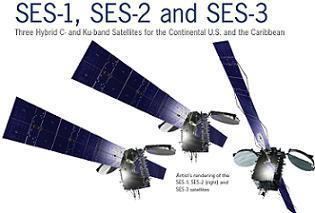Mission type Communication COSPAR ID 2010-016A Period 24 hours | Mission duration 15 years (planned) Speed on orbit 3.07 km/s Launch date 24 April 2010 | |
 | ||
Launch mass 3,170 kilograms (6,990 lb) Similar SES‑2, SES‑3, AMC‑18, SES‑5, AMC‑21 | ||
Liftoff of the orbital built ses 1 satellite aboard a ils proton m rocket
SES-1 is a geostationary communications satellite which is operated by SES World Skies. It was originally ordered by SES Americom as a ground spare for AMC-5R, however in April 2008 a decision was made to launch it, and it was named AMC-1R. It was subsequently renamed AMC-4R, and finally SES-1 after SES Americom merged with SES New Skies to form SES World Skies. It was the third World Skies satellite to be launched following the merger, but the first to carry the new SES designation. SES-1 operates in geostationary orbit, and is intended to be located at a longitude of 101 degrees West, where it will replace the AMC-2 and AMC-4 satellites, and be used broadcast high-definition television to very small aperture terminals in the United States.
SES-1 was built by Orbital Sciences Corporation, and is based on the Star-2.4 satellite bus. It is equipped with 24 G/H band (IEEE C band), and 24 J band (IEEE Ku band) transponders, and at launch it had a mass of 3,170 kilograms (6,990 lb). It has a design life of fifteen years, however it was launched with enough fuel to operate for at least sixteen if its systems are still functional.
The launch of SES-1 was conducted by International Launch Services, using a Proton-M carrier rocket with a Briz-M upper stage. The launch occurred from Site 200/39 at the Baikonur Cosmodrome, at 11:19:00 GMT on 24 April 2010. The launch successfully placed SES-1 into a subsynchronous orbit close to geostationary altitude.
In May and June 2010, SES-1 was positioned close to 131° West to temporarily provide backup to the AMC-11 satellite in the event that AMC-11 could not continue broadcasting whilst it is moved out of the way of the failed Galaxy 15 satellite, which passed close to it at the end of May. In the end, services provided by AMC-11 were not interrupted.
